Vol. 148, No. 9 — April 23, 2014
Registration
SOR/2014-82 April 4, 2014
MOTOR VEHICLE SAFETY ACT
Regulations Amending the Motor Vehicle Safety Regulations (Various Amendments)
P.C. 2014-359 April 3, 2014
Whereas, pursuant to subsection 11(3) of the Motor Vehicle Safety Act (see footnote a), a copy of the proposed Regulations Amending the Motor Vehicle Safety Regulations (Various Amendments), substantially in the annexed form, was published in the Canada Gazette, Part I, on June 1, 2013 and a reasonable opportunity was afforded to interested persons to make representations to the Minister of Transport with respect to the proposed Regulations;
Therefore, His Excellency the Governor General in Council, on the recommendation of the Minister of Transport, pursuant to subsections 5(1) (see footnote b) and 11(1) of the Motor Vehicle Safety Act (see footnote c), makes the annexed Regulations Amending the Motor Vehicle Safety Regulations (Various Amendments).
REGULATIONS AMENDING THE MOTOR VEHICLE SAFETY REGULATIONS (VARIOUS AMENDMENTS)
AMENDMENTS
1. Section 110 of Part II of Schedule IV to the Motor Vehicle Safety Regulations (see footnote 1) is replaced by the following:
110. (1) Every motor vehicle with a GVWR of 4 536 kg or less — except motorcycles other than motor tricycles equipped with passenger car tires, restricted-use motorcycles, three-wheeled vehicles equipped with tires other than passenger car tires, vehicles imported temporarily for special purposes and low-speed vehicles — and every tire rim manufactured for use on those vehicles shall conform to the requirements of Technical Standards Document No. 110, Tire Selection and Rims for Motor Vehicles With a GVWR of 4,536 kg or Less (TSD 110), as amended from time to time.
Technical Standards Document No. 110
(2) Except as provided in subsections (3) and (4), the information specified in S4.3 and S4.3.5 of TSD 110 shall appear, at the option of the manufacturer, either
- (a) in both official languages on one vehicle placard, as shown in Figure 3, or, if the manufacturer chooses to use a tire inflation pressure label, on one placard and one label, as shown in Figures 3 and 6; or
- (b) in each official language on two vehicle placards, as shown in Figures 1 and 2, or, if the manufacturer chooses to use a tire inflation pressure label, on two placards and two labels, as shown in Figures 1, 2, 4 and 5, affixed at the same location on the vehicle but apart.
(3) The information specified in S4.3(f) of TSD 110 that appears on a vehicle placard and, at the manufacturer’s option, on a tire inflation pressure label, in accordance with paragraph (2)(a), shall appear either
- (a) in the form of the symbol number N.03 for Operator’s manual, operation instructions, that is included in International Standard ISO 2575, entitled Road vehicles — Symbols for controls, indicators and tell-tales, 7th edition, May 1, 2004; or
- (b) in both official languages on one placard, as shown in Figure 3, or on one placard and one label, as shown in Figures 3 and 6.
(4) The information specified in S4.3(f) of TSD 110 that appears on a vehicle placard and, at the manufacturer’s option, on a tire inflation pressure label, in accordance with paragraph 2(b), shall appear either
- (a) in the form of the symbol number N.03 specified in paragraph (3)(a); or
- (b) in each official language on two placards, as shown in Figures 1 and 2, or on two placards and two labels, as shown in Figures 1, 2, 4 and 5, affixed at the same location on the vehicle but apart.
(5) The words “Voir le manuel de l’usager pour plus de renseignements”, in the French version of the information specified in S4.3(f) of TSD 110, may, at the option of the manufacturer, be replaced by the words “Voir le guide du propriétaire pour plus de renseignements”, “Voir le manuel du propriétaire pour plus de renseignements” or “Voir le guide de l’automobiliste pour plus de renseignements”.
(6) The information specified in S4.3.3 of TSD 110 shall be in both official languages.
(7) The following definitions apply for the purposes of TSD 110.
- “load rating” means the maximum load a tire is rated to carry at a given inflation pressure. (charge nominale)
- “maximum load rating” means the load rating at the maximum permissible inflation pressure for that tire. (limite de charge nominale)
- “rim base” means that portion of a rim remaining after the removal of all split or continuous rim flanges, side rings, and locking rings that can be detached from the rim. (base de jante)
Load Range Identification Symbol
(8) In the case of vehicles equipped with light-truck tires, the load range identification symbol shall appear either on the compliance label required by section 6 of these Regulations or on the vehicle placard or tire inflation pressure label, after the tire size designation.
Expiry Date
(9) This section expires on March 31, 2018.
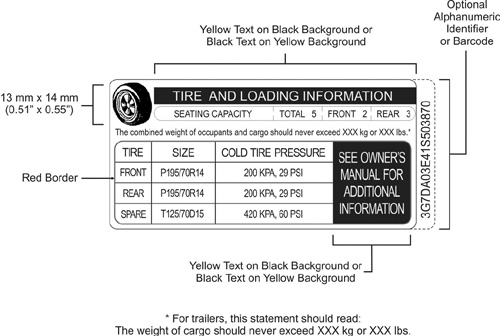
Figure 1 — Vehicle Placard, Unilingual English Example

Figure 2 — Vehicle Placard, Unilingual French Example
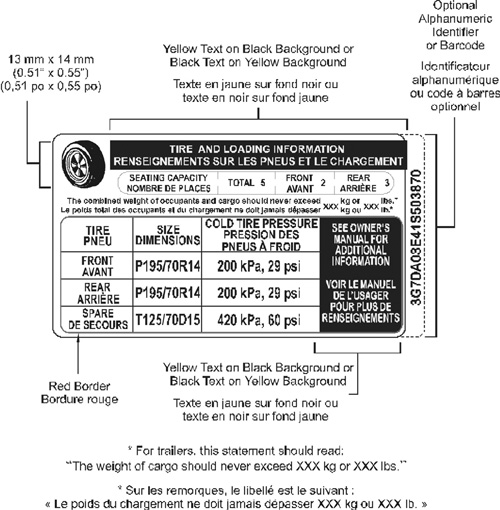
Figure 3 — Vehicle Placard, Bilingual Example
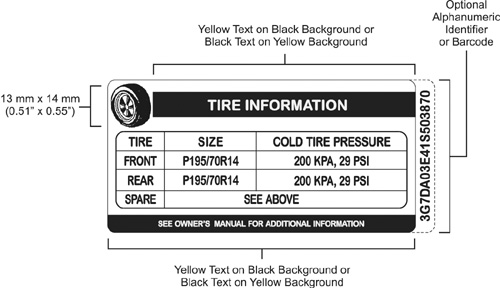
Figure 4 — Tire Inflation Pressure Label, Unilingual English Example
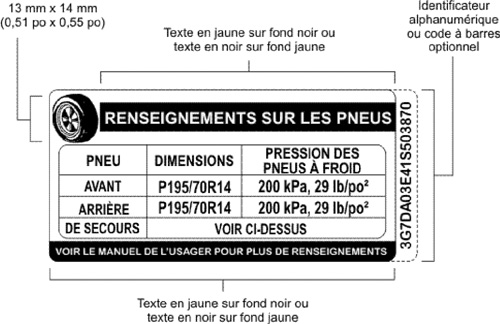
Figure 5 — Tire Inflation Pressure Label, Unilingual French Example
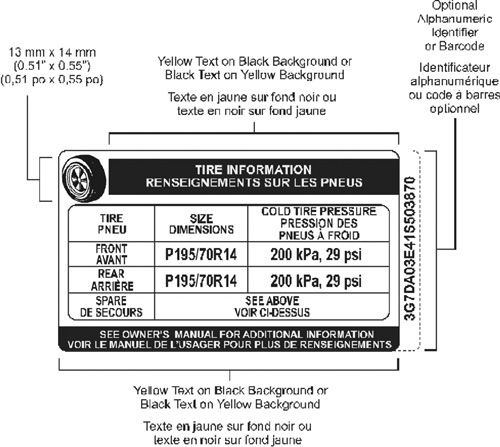
Figure 6 — Tire Inflation Pressure Label, Bilingual Example
2. Subsections 114(1) to (3) of Part II of Schedule IV to the Regulations are replaced by the following:
114. (1) With the exception of a walk-in van, every passenger car, every three-wheeled vehicle, and every multi-purpose passenger vehicle and truck with a GVWR of 4 536 kg or less shall conform to the requirements of Technical Standards Document No. 114, Theft Protection and Rollaway Prevention (TSD 114), as amended from time to time.
(2) The term “self-mobility” in TSD 114 means movement of a vehicle under its own power.
(3) This section expires on March 31, 2018.
3. Section 120 of Part II of Schedule IV to the Regulations is replaced by the following:
120. (1) Every motor vehicle with a GVWR of more than 4 536 kg, except vehicles imported temporarily for special purposes, every three-wheeled vehicle equipped with tires other than passenger car tires, every motorcycle except motor tricycles equipped with passenger car tires, and every tire rim manufactured for use on those vehicles shall conform to the requirements of Technical Standards Document No. 120, Tire Selection and Rims for Motor Vehicles With a GVWR of More Than 4,536 kg (TSD 120), as amended from time to time.
Technical Standards Document No. 120
(2) In addition to conforming to the requirements of S5.1.3 of TSD 120, used or retreaded tires installed on a bus, trailer, trailer converter dolly or truck shall
- (a) not have been the subject of a notice of defect;
- (b) have a tread depth greater than 1.5 mm; and
- (c) have been originally manufactured to conform to the requirements of any of the following that applied at the time of manufacture:
- (i) in the case of used tires, the Motor Vehicle Tire Safety Regulations or the Motor Vehicle Tire Safety Regulations, 1995, and
- (ii) in the case of retreaded tires, section 4 of the Motor Vehicle Tire Safety Regulations, Schedule V to the Motor Vehicle Tire Safety Regulations, 1995, the United States Federal Motor Vehicle Safety Standard No. 119 or the Japanese Industrial Standard JIS D4230.
(3) The information specified in S5.3 of TSD 120 shall be in both official languages.
(4) The following definitions apply for the purposes of TSD 120.
- “load rating” means the maximum load a tire is rated to carry at a given inflation pressure. (charge nominale)
- “maximum load rating” means the load rating at the maximum permissible inflation pressure for that tire. (limite de charge nominale)
Load Range Identification Symbol
(5) In the case of vehicles equipped with light-truck tires, the load range identification symbol shall appear either on the compliance label required by section 6 of these Regulations or on the tire information label.
Expiry Date
(6) This section expires on March 31, 2018.
4. Section 122 of Part II of Schedule IV to the Regulations is replaced by the following:
122. (1) Every motorcycle shall conform to
- (a) the requirements of Technical Standards Document No. 122, Motorcycle Brake Systems (TSD 122), as amended from time to time; or
- (b) the requirements set out in paragraphs 5 and 6 and Annex 3 of ECE Regulation No. 78, Revision 1, Uniform Provisions Concerning the Approval of Vehicles of Categories L1, L2, L3, L4 and L5 with Regard to Braking, in the version in effect on June 24, 2008, as amended by any subsequent amendments in the 03 series of amendments (ECE Regulation No. 78).
(2) If a motorcycle is designed to operate with or without a side- car, it shall conform to the requirements of subsection (1) in each of those configurations.
(3) Every motorcycle shall have a mark containing the symbol “DOT” followed by a reference to the type of brake fluid recommended by the manufacturer.
(4) The mark shall
- (a) be permanently affixed and of a colour that contrasts with its background, or be engraved or embossed;
- (b) be located, so as to be visible without obstruction, either on or within 101.6 mm of the brake-fluid reservoir filler plug or cap; and
- (c) have letters and numbers at least 2.38 mm in height.
(5) The English and French versions of the owner’s manual shall include, respectively, the English or French version of the following warning about brake fluid:
“WARNING: Clean filler cap before removing. Use only [here insert the information contained on the mark referred to in subsection (3)] fluid from a sealed container.”
« AVERTISSEMENT : Nettoyer le bouchon de remplissage avant de l’enlever. Utiliser seulement du liquide [insérer ici les renseignements figurant sur la marque visée au paragraphe (3)] provenant d’un contenant scellé. »
Technical Standards Document No. 122
(6) The term “three-wheeled motorcycle” used in TSD 122 means
- (a) for the purposes of S5.1.4 of that document, a motorcycle that is designed to travel on three wheels in contact with the ground; and
- (b) for the purposes of S6.7 and S7.8.2 of that document,
- (i) a motorcycle that is designed to travel on three wheels in contact with the ground, or
- (ii) a motorcycle that is designed to travel on two wheels in contact with the ground and that is equipped with a sidecar.
(7) Despite S5.1.3.1(d) of TSD 122, the indicator lamp shall display the identification symbol set out in Table II to section 101 of this schedule for a brake system malfunction, but the use of the legend referred to in S5.1.3.1(d) of TSD 122 is optional.
(8) The vehicle mass referred to in S6.1 of TSD 122 is limited to a maximum value equal to the GVWR of the motorcycle.
(9) Despite S5.4, S5.5, S7.6, S7.7 and S7.8 of TSD 122, a limited-speed motorcycle shall conform to the test requirements set out in those sections.
(10) Despite S6.6 of TSD 122, the wind velocity shall be not more than 5 m/s.
(11) For the purposes of S7.6.2 of TSD 122, if a motorcycle is incapable of attaining the required test speed, it shall be tested at the speed attainable in 1.6 km (1 mile).
ECE Regulation No. 78
(12) For the purposes of this section,
- (a) a reference to vehicle category “L1” in ECE Regulation No. 78 is a reference to a limited-speed motorcycle that is designed to travel on two wheels in contact with the ground and that has a maximum speed of 50 km/h or less;
- (b) a reference to vehicle category “L2” in ECE Regulation No. 78 is a reference to a limited-speed motorcycle that is designed to travel on three wheels in contact with the ground and that has a maximum speed of 50 km/h or less;
- (c) a reference to vehicle category “L3” in ECE Regulation No. 78 is a reference to a motorcycle that is designed to travel on two wheels in contact with the ground, that has a maximum speed of more than 50 km/h and that is not equipped with a sidecar;
- (d) a reference to vehicle category “L4” in ECE Regulation No. 78 is a reference to a motorcycle that is designed to travel on two wheels in contact with the ground and that is equipped with a sidecar, and to a motorcycle that is designed to travel on three wheels in contact with the ground that are asymmetrically arranged in relation to the longitudinal median plane; and
- (e) a reference to vehicle category “L5” in ECE Regulation No. 78 is a reference to a motorcycle that has a maximum speed of more than 50 km/h and that is designed to travel on three wheels in contact with the ground that are symmetrically arranged in relation to the longitudinal median plane.
(13) For the purposes of this section and despite the definition “three-wheeled vehicle” in subsection 2(1) of these Regulations, the term “three-wheeled vehicle” used in ECE Regulation No. 78 means a motorcycle that is designed to travel on two wheels in contact with the ground and that is equipped with a sidecar, and a motorcycle that is designed to travel on three wheels in contact with the ground.
(14) For the purposes of paragraph 1.1.3 of Annex 3 of ECE Regulation No. 78, the peak braking coefficient shall be measured in accordance with paragraph 1.1.3(a) of that Regulation.
(15) For the purposes of paragraph 2.4 of Annex 3 of ECE Regulation No. 78, the brake temperature shall be measured in accordance with paragraph 2.4(b) of that Regulation.
(16) Despite the second sentence of paragraph 5.1.6 of ECE Regulation No. 78, sidecar wheels are never required to be equipped with a brake.
(17) The warning lamp referred to in paragraph 5.1.12 of ECE Regulation No. 78 shall display the identification symbol set out in Table II to section 101 of this schedule that corresponds to a brake system malfunction.
(18) The warning lamp referred to in paragraph 5.1.13 of ECE Regulation No. 78 shall display the identification symbol set out in Table II to section 101 of this schedule that corresponds to an antilock brake system malfunction.
Expiry Date
(19) This section expires on March 31, 2018.
5. Section 202 of Part III of Schedule IV to the Regulations is replaced by the following:
202. (1) Subject to subsection (2), every multi-purpose passenger vehicle, bus or truck with a GVWR of 4 536 kg or less, every passenger car and every three-wheeled vehicle shall conform to the requirements of Technical Standards Document No. 202, Head Restraints (TSD 202), as amended from time to time.
(2) This section expires on March 31, 2018.
6. Section 216 of Part III of Schedule IV to the Regulations is replaced by the following:
216. (1) Every passenger car, multi-purpose passenger vehicle, truck or bus with a GVWR of 4 536 kg or less, except trucks with a GVWR greater than 2 722 kg built from a cutaway chassis, school buses and convertibles, shall conform to the requirements of Technical Standards Document No. 216, Roof Crush Resistance (TSD 216), as amended from time to time.
(2) Every passenger car, multi-purpose passenger vehicle, truck or bus with a GVWR of 4 536 kg or less that is built in two or more stages not using a chassis-cab and every passenger car, multipurpose passenger vehicle, truck or bus with a GVWR greater than 2 722 kg but not greater than 4 536 kg that has an altered roof shall conform to the requirements of TSD 216 or TSD 220, which is referred to in section 220 of this schedule.
(3) Until August 31, 2016, the vehicles referred to in subsections (1) and (2) may conform to the requirements of this section as it read on the day before the day on which this version of the section came into force.
(4) This section expires on March 31, 2018.
7. Section 220 of Part III of Schedule IV to the Regulations is replaced by the following:
220. (1) Every school bus shall conform to the requirements of Technical Standards Document No. 220, Rollover Protection (TSD 220), as amended from time to time.
(2) Every passenger car, multi-purpose passenger vehicle, truck or bus with a GVWR of 4 536 kg or less that is built in two or more stages not using a chassis-cab and every passenger car, multipurpose passenger vehicle, truck or bus with a GVWR greater than 2 722 kg but not greater than 4 536 kg that has an altered roof shall conform to the requirements of TSD 220 or TSD 216, which is referred to in section 216 of this schedule.
(3) This section expires on March 31, 2018.
COMING INTO FORCE
8. These Regulations come into force on the day on which they are published in the Canada Gazette, Part II.
REGULATORY IMPACT ANALYSIS STATEMENT
(This statement is not part of the Regulations.)
Issues
According to subsection 12(4) of the Motor Vehicle Safety Act (MVSA), a section of the Motor Vehicle Safety Regulations (MVSR) that incorporates by reference a Technical Standards Document (TSD) must expire no later than five years after the day on which it came into force. This allows for the review of comments received pertaining to the TSD during the five-year period. Several TSDs incorporated by reference in the MVSR are approaching their expiration dates and if they are allowed to expire, the safety requirements they contain, which help ensure the safety of the Canadian driving public, will cease to be a requirement under the MVSA.
Objectives
Transport Canada (the Department) must re-enact certain sections of Schedule IV to the MVSR with new expiration dates in order to continue the application of the safety requirements and the TSDs that are incorporated by reference.
Description
This modification amends the expiry date for seven sections of Schedule IV to the MVSR. The sections of Schedule IV that have been amended are the following:
- 110, Tire Selection and Rims for Motor Vehicles With a GVWR of 4 536 KG or Less;
- 114, Theft Protection and Rollaway Prevention;
- 120, Tire Selection and Rims for Motor Vehicles With a GVWR of More Than 4 536 KG;
- 122, Motorcycle Brake Systems;
- 202, Head Restraints;
- 216, Roof Crush Resistance; and
- 220, Rollover Protection.
The new expiration date for these sections is March 31, 2018.
Technical Standards Documents form most, or in some cases all, of the safety requirements for new motor vehicles offered for sale in Canada. As authorized by section 12 of the MVSA, a TSD reproduces an enactment of a foreign government (e.g. a Federal Motor Vehicle Safety Standard [FMVSS] issued by the United States National Highway Traffic Safety Administration).
Technical Standards Documents are published by the Department and then amended from time to time. These amendments may include deletion of material that does not apply under the MVSA and the MVSR, introduction of equivalent metric measurements, deletion of superseded dates, substitution of United States reporting requirements with equivalent Canadian requirements, translated (French) text and other editorial changes.
“One-for-One” Rule
The “One-for-One” Rule does not apply to this amendment, as there is no change in administrative costs to businesses.
Small business lens
The small business lens does not apply to this amendment, as the vast majority of motor vehicle manufacturers selling into the Canadian marketplace are not small businesses and are not domiciled in Canada.
Consultation
The Department informs the automotive industry, public safety organizations, and the general public when changes are planned to the MVSR. This gives them the opportunity to comment on these changes by letter or email. The Department also consults regularly, in face-to-face meetings or teleconferences, with the automotive industry, public safety organizations, the provinces, and the territories.
Finally, the Department meets regularly with the federal authorities of other countries. Harmonized regulations are key to trade and to a competitive Canadian automotive industry. The Department and the United States Department of Transportation hold semi-annual meetings to discuss issues of mutual importance and planned regulatory changes. In addition, departmental officials participate in and support the development of Global Technical Regulations, which are developed by the World Forum for the Harmonization of Vehicle Regulations under the direction of the United Nations Economic Commission for Europe.
The intent to move forward with this regulatory initiative was included in the Transport Canada Vehicle Safety Regulatory Plan that is distributed to the automotive industry and other stakeholders, either directly or through various industry and other associations. No negative comments were received. In meetings and correspondence, the regulatory strategy to re-enact sections of the MVSR referring to TSDs has been universally supported by the stakeholders.
Notice of the Transport Canada’s intention to make this amendment was published in the Canada Gazette, Part I, on June 1, 2013, followed by a 30-day comment period. Following the Part I publication, no comments were received from interested persons or stakeholders.
Rationale
Re-enactment of the sections of the MVSR listed allows the continuous application of their requirements, which is imperative to the safety of Canada’s driving public. In addition, the continuing application of TSDs harmonizes motor vehicle safety requirements with those of the United States.
Implementation, enforcement and service standards
Motor vehicle manufacturers and importers are responsible for ensuring compliance with the requirements of the Motor Vehicle Safety Act and its regulations. The Department of Transport monitors the self-certification programs of manufacturers and importers by reviewing their test documentation, inspecting vehicles, and testing vehicles obtained in the open market. In addition, when they identify a defect in a vehicle or equipment, manufacturers and importers must issue a notice of defect to the owners and to the Minister of Transport. Any person or company that contravenes a provision of the Motor Vehicle Safety Act or its regulations is guilty of an offence, and liable to the applicable penalty set out in the Act.
Contact
Kyle Buchanan
Regulatory Development Engineer
Road Safety and Motor Vehicle Regulation Directorate
Transport Canada, Road Safety
330 Sparks Street, 11th Floor
Ottawa, Ontario
K1A 0N5
Telephone: 613-998-1949
Fax: 613-998-8188
Email: kyle.buchanan@tc.gc.ca
- Footnote a
S.C. 1993, c. 16 - Footnote b
S.C. 1999, c. 33, s. 351 - Footnote c
S.C. 1993, c. 16 - Footnote 1
C.R.C., c. 1038